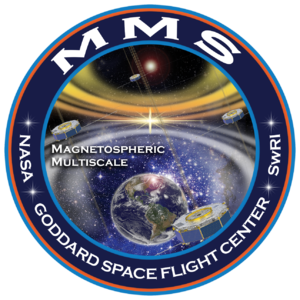Magnetospheric Multiscale Mission
| Magnetospheric Multiscale Mission | |
|---|---|

|
|
| Operator: | NASA |
| Mission dates | |
| Dimensions: | 1360 kg |
| Size: | 3.5 × 1.23 m |
| Begin: | March 13, 2015 at 2:44 a.m. UTC |
| Starting place: | Cape Canaveral AFS, SLC-41 |
| Launcher: | Atlas V (421) |
| Status: | active |
| Orbit data | |
| Apogee height : | 2550 km |
| Perigee height : | 70,000 km |
The Magnetospheric Multiscale Mission (MMS) is a NASA research project that aims to investigate the interplay between the magnetic fields of the earth and the sun.
The focus of the investigations is the so-called magnetic reconnection , in which magnetic energy is converted into particle energy, which causes magnetic storms and phenomena such as aurora borealis on earth .
description
For the measurements on March 13, 2015 at 2:44 a.m., four identical satellites were brought into a highly elliptical earth orbit with an Atlas V rocket from the SLC-41 of Cape Canaveral AFS . The satellites have an octagonal shape with a diameter of 3.5 m and a height of 1.23 m and a mass of 1360 kg each. In orbit, eight booms are extended for measurements, two of which are 12.5 m long for electrical fields, two 5 m long for magnetic fields and four sensors for electrical fields on 60 m long cables. The satellites move around the earth in the form of a pyramid at a distance of 10 and 400 kilometers and should enable a three-dimensional and temporally high-resolution measurement of the processes in the earth's magnetic field. This is intended to improve understanding of how the magnetic fields affect what is known as space weather . Each probe is equipped with 25 sensors, some of which collect data for eleven experiments every millisecond. The sensors measure, among other things, the energy of charged particles, the movement of the plasma and the strength of electrical and magnetic fields. The satellites initially carry out their measurements on an orbit with an orbit height between 2500 and 70,000 km. After about 18 months, they will be brought into orbit at an altitude of around 150,000 kilometers and continue their measurements there.
The satellites are supplied with energy by eight solar cell panels and an accumulator for energy storage. The propulsion system for orbit control and stabilization consists of 12 hydrazine engines with four fuel tanks in the central part of the satellite. The satellites are spin stabilized at three revolutions per minute. Four star sensors , two three-axis accelerometers, two sun sensors and GPS receivers provide information for orbit control .
The $ 3.7 billion mission is being managed on behalf of NASA by the Southwest Research Institute (SwRI), San Antonio, USA. The University of New Hampshire , the Goddard Space Flight Center , the Applied Physics Laboratory and the Graz Institute for Space Research (IWF) make important contributions.
Instruments
The eleven instruments consist of:
- Plasma measurements
- Fast plasma investigation
- Dual Ion Sensors (DIS)
- Dual Electron Sensors (DES)
- Data Processing Unit (IDPU)
- Hot Plasma Composition Analyzer (HPCA)
- Measurement of high energy particles
- Fly's Eye Energetic Particle Sensor (FEEPS)
- Energetic Ion Spectrometer (EIS)
- Field measurements
- Analog Fluxgate Magnetometer (AFG)
- Digital Fluxgate Magnetometer (DFG)
- Electron Drift Instrument (EDI)
- Spin-plane double probe (SDP)
- Axial Double Probe (ADP)
- Search Coil Magnetometer (SCM)
Web links
- MMS-SMART Library swri.edu
- Magnetospheric Multiscale Mission's channel, YouTube
- Current position and orbit in space
Individual evidence
- ↑ GSFC: Magnetospheric Multiscale Spacecraft , accessed on March 21, 2015
- ↑ a b NASASpaceFlight.com: MMS successfully launched by ULA's Atlas V , accessed on March 21, 2015
- ↑ NASA: MMS Spacecraft & Instruments , accessed March 21, 2015
- ↑ Graz Institute for Space Research: MMS ( Memento of the original from March 22, 2015 in the Internet Archive ) Info: The archive link was automatically inserted and not yet checked. Please check the original and archive link according to the instructions and then remove this notice. , accessed on March 21, 2015
